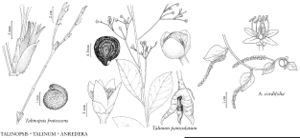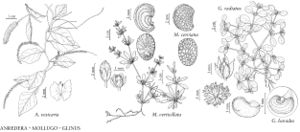Difference between revisions of "Basellaceae"
FNA>Volume Importer |
FNA>Volume Importer |
||
| Line 13: | Line 13: | ||
}}<!-- | }}<!-- | ||
| − | --><span class="statement" id="st- | + | --><span class="statement" id="st-undefined" data-properties=""><b>Vines </b>[herbs], perennial, succulent, mucilaginous, glabrous. <b>Leaves</b> alternate, sessile or petiolate; blade margins entire [toothed]; stipules absent. <b>Inflorescences</b> axillary or terminal, racemose, [spicate, or paniculate], bracteate. <b>Flowers</b> usually bisexual, sessile or pedicellate, subtended by 1–2 bracts; perianth hypogynous, hypanthium present; sepals 2, distinct or basally connate; petals [4–]5[–13], basally connate; nectary annular; stamens [4–]5[–9], epipetalous, basally connate; filaments erect or reflexed in bud, broadened at base; anthers [basifixed]versatile, 4-locular, dehiscence longitudinal [terminal]; pollen [6-] pantoporate; pistils 3-carpellate, unilocular; placentation basal; ovule 1; styles 3, basally connate; stigmas slender, bifid to clavate or capitate [or style 1, with stigma capitate to 3-lobed]. <b>Fruits</b> utricles, surrounded by dry or fleshy perianth, winged or not. <b>Seeds</b> usually rust colored, testa membranous; endosperm copious; embryo curved.</span><!-- |
-->{{Treatment/Body | -->{{Treatment/Body | ||
| Line 59: | Line 59: | ||
|publication year= | |publication year= | ||
|special status= | |special status= | ||
| − | |source xml=https://jpend@bitbucket.org/aafc-mbb/fna- | + | |source xml=https://jpend@bitbucket.org/aafc-mbb/fna-data-curation.git/src/9216fc802291cd3df363fd52122300479582ede7/coarse_grained_fna_xml/V4/V4_1028.xml |
| − | |||
| − | |||
| − | |||
| − | |||
| − | |||
| − | |||
| − | |||
| − | |||
| − | |||
| − | |||
| − | |||
| − | |||
| − | |||
| − | |||
| − | |||
| − | |||
| − | |||
| − | |||
| − | |||
| − | |||
| − | |||
| − | |||
| − | |||
| − | |||
| − | |||
| − | |||
| − | |||
| − | |||
| − | |||
| − | |||
| − | |||
| − | |||
| − | |||
| − | |||
| − | |||
| − | |||
| − | |||
| − | |||
| − | |||
| − | |||
| − | |||
| − | |||
| − | |||
| − | |||
| − | |||
| − | |||
}}<!-- | }}<!-- | ||
-->[[Category:Treatment]] | -->[[Category:Treatment]] | ||
Revision as of 14:56, 27 July 2019
Vines [herbs], perennial, succulent, mucilaginous, glabrous. Leaves alternate, sessile or petiolate; blade margins entire [toothed]; stipules absent. Inflorescences axillary or terminal, racemose, [spicate, or paniculate], bracteate. Flowers usually bisexual, sessile or pedicellate, subtended by 1–2 bracts; perianth hypogynous, hypanthium present; sepals 2, distinct or basally connate; petals [4–]5[–13], basally connate; nectary annular; stamens [4–]5[–9], epipetalous, basally connate; filaments erect or reflexed in bud, broadened at base; anthers [basifixed]versatile, 4-locular, dehiscence longitudinal [terminal]; pollen [6-] pantoporate; pistils 3-carpellate, unilocular; placentation basal; ovule 1; styles 3, basally connate; stigmas slender, bifid to clavate or capitate [or style 1, with stigma capitate to 3-lobed]. Fruits utricles, surrounded by dry or fleshy perianth, winged or not. Seeds usually rust colored, testa membranous; endosperm copious; embryo curved.
Distribution
North America, West Indies, Central America, South America, Eurasia, Africa, Australia.
Discussion
Genera 4, species 20 (1 genus, 2 species in the flora).
Several members of Basellaceae are edible. Tubers of “ulluco” (Ullucus tuberosus Caldas) were probably an important crop in Peru and Ecuador in pre-Columbian times, possibly as early as 4200 b.p. (C. R. Sperling 1987), and they are a significant source of protein and carbohydrates (S. R. King and S. N. Gershoff 1987; L. Pietilä and P. Jokela 1988; C. R. Sperling and S. R. King 1988). Tubers or starchy rhizomes of Anredera species are also eaten. Basella alba Linnaeus (Malabar spinach, native to Africa and Asia) is widely cultivated in tropical and subtropical areas, where it is used as a vegetable (E. O. Lucas 1988; S. C. Tiwari et al. 1988). Anredera and Basella are sometimes grown as ornamentals (J. Steffey 1987). In southeastern Asia, a red pigment extracted from Basella alba has been used as food coloring and as a substitute for carmine dye (A. L. Bogle 1969). Extracts from B. alba leaves inhibit replication of herpes simplex virus in cell cultures (M. H. C. Lagrota et al. 1995).
Basellaceae were formerly placed among Chenopodiaceae (G. Bentham and J. D. Hooker 1862–1883, vol. 3) or Portulacaceae (A. P. de Candolle and A. L. P. P. de Candolle 1823–1873, vol. 3; G. Nageshwar and M. Radhakrishnaiah 1993). The family was erected in 1840 and has been supported by many studies. A phenetic analysis of the Centrospermae placed Basellaceae close to Didiereaceae (J. E. Rodman et al. 1984), as did several chloroplast DNA studies (M. W. Chase et al. 1993; S. R. Downie and J. D. Palmer 1994; S. R. Downie et al. 1997; J. H. Rettig et al. 1992), which also showed a close relationship with at least a portion of Portulacaceae and Cactaceae. A study of pollen morphology (J. W. Nowicke 1996) supported close relationships among Basellaceae, Didiereaceae, and Portulacaceae.
Some authors consider the pair of sepals to be bracts and the petals to be sepals, based on anatomical studies (H. P. Sharma 1961; C. R. Sperling 1987).
Basella alba has been reported for North America (J. T. Kartesz 1994; P. Wilson 1932e). However, searches of herbaria failed to reveal any noncultivated specimens of the genus. Cultivated material was seen from California, Indiana, Kentucky, Louisiana, Maryland, Massachusetts, New York, South Carolina, and Wisconsin.
The only monograph of the family since 1849 is that of C. R. Sperling (1987).

